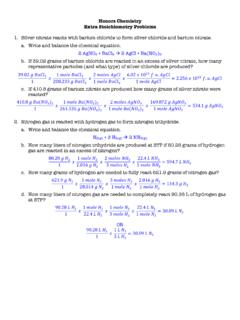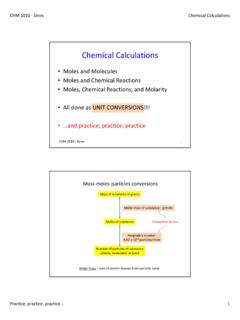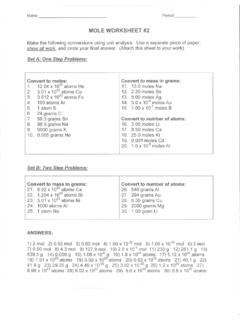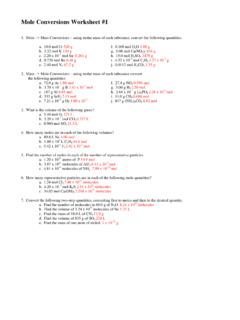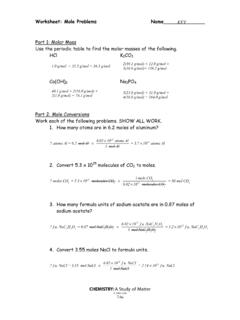Transcription of Chapter 10: The Mole - Middlesex County Vocational and ...
1 318 The Mole50-cent rollsSingle pennyChemFacts The Mint has never officially produced a coin called the penny ; the official name is the United States one-cent coin. The present-day penny is copper-plated zinc, and has a composition of Zn and Cu. The Denver and Philadelphia Mints produce 65 million to 80 million coins a the mole represents a large number of extremely small Measuring MatterMAINIdea Chemists use the mole to count atoms, molecules, ions, and formula Mass and the MoleMAINIdea A mole always contains the same number of particles ; however, moles of different substances have different moles of CompoundsMAINIdeaThe molar mass of a compound can be calculated from its chemical formula and can be used to convert from mass to moles of that Empirical and Molecular FormulasMAINIdea A molecular formula of a compound is a whole-number multiple of its empirical formula. Formulas of HydratesMAINIdea Hydrates are solid ionic compounds in which water molecules are trapped.
2 (t) Tom Pantages, (b) Royalty-Free/Corbis, (bkgd) Tom Stack/Tom Stack & AssociatesChapter 10 the mole 319 Start-Up ActivitiesStart-Up ActivitiesLLAAUUNCH NCH LabLabHow much is a mole?Counting large numbers of items is easier when you use counting units such as decades or dozens. Chemists use a counting unit called the 1. Read and complete the lab safety Select an item to measure, such as a paper clip, gum drop, or marshmallow, from the choices provided by your : Do not eat or taste any items used in the Use a ruler to measure the length of your item to the nearest Calculate If a mole is 10 23 items, how far will a mole of your items, placed end-to-end length-wise, extend into space? Express your answer in Calculate Convert the distance in Question 1 to light-years (ly). (1 ly = 10 15 m )3. Compare the distance you calculated in Question 2 with these astronomical distances:a. distance to nearest star (other than the Sun) = lyb.
3 Distance to the center of our galaxy = 30,000 lyc. distance to nearest galaxy = 2 10 6 l yInquiry Compare your item to another used by one of your classmates. Would a mole of your item have the same mass as a mole of the other item? Design an inves-tigation to determine if there is a relationship between mass and moles . STEP 1 Collect three sheets of paper. Fold each sheet in half. Measure and draw a line about 3 cm from the left edge. Cut along the line to the fold. Repeat for each sheet of paper. STEP 2 Label each topsheet with a description of the conversion factor. STEP 3 Staple the sheets together along the outer edge of the narrow ,$!",%3 Use this Foldable with Sections , , and As you read the sections, record information about conversion factors and summarize the steps involved in each conversion. Conversion Factors Make the following Foldable to help you organize information about conversion ParticlesConversion FactorsMoles/Numberof ParticlesConversion FactorsVisit to: study the entire Chapter online explore take Self-Check Quizzes use the Personal Tutor to work Example Problems step-by-step access Web Links for more information, projects, and activities find the Try at Home Lab, Calculating Carbon PercentagesMatt Meadows320 Chapter 10 The MoleSection MatterMAINIdeaChemists use the mole to count atoms, molecules, ions, and formula Reading Link Has your class ever had a contest to guess how many pennies or jelly beans were in a jar?
4 You might have noticed that the smaller the object is, the harder it is to ParticlesIf you were buying a bouquet of roses for a special occasion, you probably would not ask for 12 or 24; you would ask for one or two dozen. Similarly, you might buy a pair of gloves, a ream of paper for your printer, or a gross of pencils. Each of the units shown in Figure a pair, a dozen, a gross, and a ream represents a specific number of items. These units make counting objects easier. It is easier to buy and sell paper by the ream 500 sheets than by the individual of the counting units shown in Figure is appropriate for certain kinds of objects, depending primarily on their size and function. But regardless of the object gloves, eggs, pencils, or paper the num-ber that the unit represents is always constant. Chemists also need a convenient method for accurately counting the number of atoms, mole-cules, or formula units in a sample of a substance. However, atoms are so small and there are so many of them in even the smallest sample that it is impossible to count them directly.
5 Because of this, chemists created a counting unit called the mole . In the Launch Lab, you probably found that a mole of any object is an enormous number of items. Figure Different units are used to count different types of objects. A pair is two objects, a dozen is 12, a gross is 144, and a ream is What other counting units are you familiar with?Objectives Explain how a mole is used to indirectly count the number of particles of matter. Relate the mole to a common everyday counting unit. Convert between moles and number of representative Vocabularymolecule: two or more atoms that covalently bond together to form a unitNew VocabularymoleAvogadro s numberMatt MeadowsSection Measuring Matter 321 Figure The amount of each substance shown is 1 0 23 or 1 mol of repre-sentative particles . The representative particle for each substance is shown in a box. Refer to Table R-1 on page 968 for a key to atom color mole the mole , abbreviated mol, is the SI base unit used to measure the amount of a substance.
6 A mole is defined as the number of carbon atoms in exactly 12 g of pure carbon-12. Through years of experimentation, it has been established that a mole of anything contains 10 23 representative particles . A representative particle is any kind of particle, such as an atom, a molecule, a formula unit, an electron, or an ion. If you write out Avogadro s number, it looks like ,213,670,000,000,000,000,000 The number 10 23 is called Avogadro s number, in honor of the Italian physicist and lawyer Amedeo Avogadro, who, in 1811, determined the volume of 1 mol of a gas. In this book, Avogadro s number is rounded to three significant figures, 10 23 .To count extremely small particles , such as atoms, Avogadro s num-ber must be an enormous quantity. As you might imagine, Avogadro s number would not be convenient for measuring a quantity of marbles. Avogadro s number of marbles would cover the surface of Earth to a depth of more than six kilometers! Figure , however, shows that it is convenient to use the mole to measure amounts of substances.
7 One-mole quantities of water, copper, and salt are shown, each with a different representative particle. The representative particle in a mole of water is the water molecule, the representative particle in a mole of copper is the copper atom, and the representative particle in a mole of sodium chloride is the NaCl formula unitMoleculeAtomVOCABULARYSCIENCE USAGE V. COMMON USAGEMoleScience usage: an SI base unit used to measure the quantity of matterThe chemist measured out a mole of the usage: a small burrowing animalThe damage to the lawn was caused by a Meadows322 Chapter 10 The MoleConverting Between moles and ParticlesSuppose you buy three-and-one-half dozen roses and want to know how many roses you have. Recall what you have learned about conver-sion factors. You can multiply the known quantity ( dozen roses) by a conversion factor to express the quantity in the units you want (number of roses). First, identify the mathematical relationship that relates the given unit with the desired unit.
8 Figure shows the relationship. Relationship: 1 dozen roses = 12 rosesBy dividing each side of the equality by the other side, you can write two conversion factors from the relationship. Conversion factors: 12 roses __ 1 dozen roses a n d 1 dozen roses __ 12 roses Then choose the conversion factor that, when multiplied by the known quantity, results in the desired unit. When set up correctly, all units cancel except those required for the answer. Conversion: dozen roses 12 roses __ 1 dozen roses = 42 rosesHere, dozens of roses cancels, leaving roses as the desired Check Describe how you can tell if the wrong conversion factor has been to particles Now suppose you want to determine how many particles of sucrose are in mol of sucrose. The relationship between moles and representative particles is given by Avogadro s mol of representative particles = 1 0 23 representative particlesUsing this relationship, you can write two different conversion factors that relate representative particles and moles .
9 10 23 representative particles ___ 1 mol 1 mol ___ 10 23 representative particles By using the correct conversion factor, you can find the number of rep-resentative particles in a given number of moles . number of moles 1 0 23 representative particles ___ 1 mol = number of representative particlesAs shown in Figure , the representative particle of sucrose is a molecule. To obtain the number of sucrose molecules contained in mol of sucrose, you need to use Avogadro s number as a conversion factor. mol sucrose 1 0 23 molecules sucrose ___ 1 mol sucrose = 1 0 24 molecules sucroseThere are 1 0 24 molecules of sucrose in mol of sucrose. Figure A key to using dimen-sional analysis is correctly identifying the mathematical relationship between the units you are converting. The relationship shown here, 12 roses = 1 dozen roses, can be used to write two conversion ,$!",%3 Incorporate information from this section into your roses = 1 dozen roses Royalty-Free/CorbisSection Measuring Matter 323 particles to moles Now suppose you want to find out how many moles are represented by a certain number of representative particles .
10 To do this, you can use the inverse of Avogadro s number as a conversion of representative particles 1 mol ___ 10 23 representative particles = number of molesFor example, if instead of knowing how many moles of sucrose you have, suppose you knew that a sample contained 10 24 molecules of sucrose. To convert this number of molecules of sucrose to moles of sucrose, you need a conversion factor that has moles in the numerator and molecules in the denominator. 10 24 molecules sucrose 1 mol ___ 10 23 molecules sucrose = mol sucroseThus, 10 24 molecules of sucrose is mol of sucrose. You can convert between moles and number of representative parti-cles by multiplying the known quantity by the proper conversion factor. Example Problem further illustrates the conversion Check List the two conversion factors that can be written from Avogadro s Problems Extra Practice Page 981 and 1. Zinc (Zn) is used to form a corrosion-inhibiting surface on galvanized steel.






